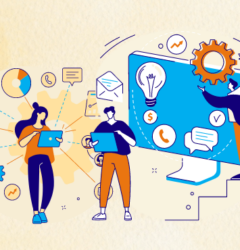
Among the many daunting phrases in the business world is “Business Process Management (BPM).” Three critical and complicated aspects of work come together to form one niche (and one phrase), so we need to tread carefully here.
But what if we told you that it is not very difficult? What if we used the word “fun” to describe it instead of the regular jargon of “boring,” “frustrating,” and “scary?”
We can hear you scream at us.
Hold on, though. We will reason all our claims by helping you understand what business process management (BPM) is, its benefits, and how you can get started with it right away.
The global Business Process Management market is expected to grow to $26.18 billion in 2028
What is Business Process Management?
Business Process Management (BPM) refers to the discipline of designing, modeling, executing, monitoring, and optimizing business processes. It brings structure and efficiency to organizational workflows by aligning people, technology, and data across different departments.
According to Gartner, organizations that adopt BPM frameworks increase project success rates by up to 70%.
BPM isn’t limited to large enterprises. Small and mid-sized businesses also benefit from streamlined operations and quicker decision-making.
Also Read: Your Guide to Warehouse Management Success
Why is Business Process Management Important?
BPM acts as the backbone of operational excellence. By refining workflows and removing inefficiencies, BPM helps:
- Increase productivity
- Enhance decision-making
- Foster collaboration across teams
- Ensure compliance and risk management
- Enable faster adaptation to market changes
Think of BPM as the conductor of an orchestra, bringing harmony between systems, teams, and processes.
Also Read: Online License Management System for Businesses : From Paperwork to Progress
Categories of Business Process Management
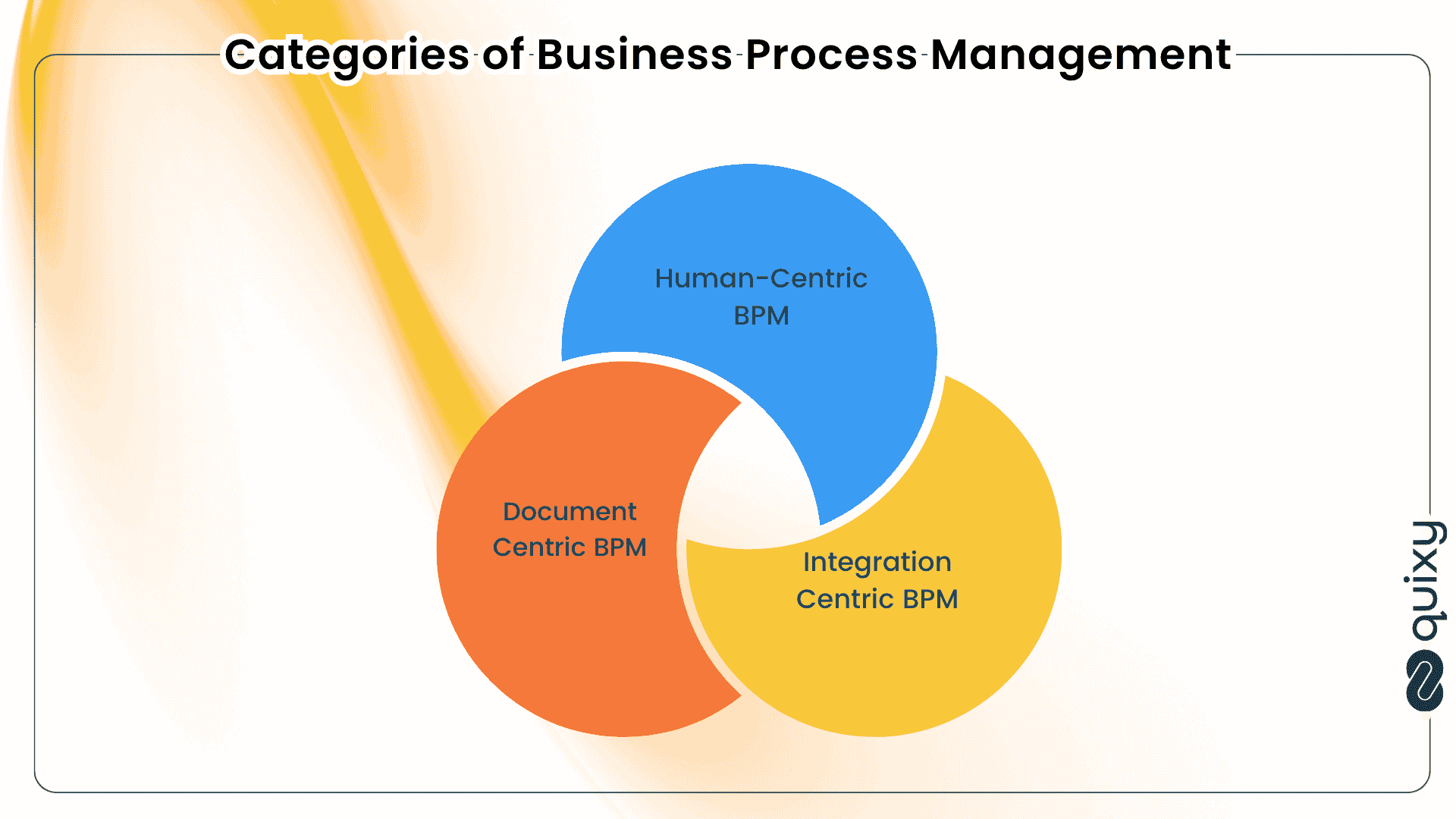
Every organization engages in BPM in some way or another, and business process management works in multiple structures. Primarily, every business needs three types of BPM in different ratios. The following is a list that would help you better understand BPM’s scope.
1. Document Centric BPM
This type of BPM revolves around the creation, routing, review, and approval of documents. It’s particularly valuable in workflows where document accuracy, compliance, and version control are non-negotiable. Think of legal contracts, audit reports, policy documents, and financial statements.
Teams in legal, finance, HR, and compliance often rely on document-centric BPM to:
- Standardize approval processes
- Maintain audit trails
- Ensure regulatory compliance
- Speed up document turnaround times
By digitizing and automating document flows, businesses reduce manual errors and maintain control over sensitive, high-stakes information.
2. Human-Centric BPM
As the name suggests, human-centric BPM centers on processes that require human judgment, decision-making, or intervention. These workflows can’t be entirely automated due to their reliance on inputs such as approvals, feedback, or exception handling.
Common in customer service, project management, and HR operations, this BPM category enables:
- Clear task assignment and ownership
- Automated reminders and escalations
- Seamless collaboration between departments
- A balanced mix of automation and human oversight
Human-centric BPM ensures that while routine steps are streamlined, people remain at the heart of critical decisions.
Also Read : What is Business Process Optimization? Proven Techniques & Insights
3. Integration Centric BPM
Integration-centric BPM is designed to connect disparate systems, databases, and applications—enabling smooth data exchange and end-to-end automation without human involvement.
Ideal for IT, supply chain, and operations teams, this approach:
- Bridges legacy systems with modern software
- Automates data syncs across tools (e.g., CRM, ERP, and BI platforms)
- Eliminates silos by creating unified, interoperable workflows
- Increases speed and consistency across high-volume operations
When scalability and system-to-system communication are essential, integration-centric BPM delivers the backbone for a digitally unified enterprise.
Also Read: A Guide to Utilizing Low-Code and Change Management: Maximizing Enterprise Agility
Here are some Key Components and Functions of a BPMS
A modern Business Process Management System (BPMS) is more than just a tool—it’s a digital backbone that empowers organizations to design, run, monitor, and continuously improve their business processes. Whether you’re looking to optimize operations, reduce manual work, or ensure compliance, a BPMS offers the structure and intelligence needed to manage it all.
Below are the core components and functions that make up an effective BPMS:
1. Process Design and Modeling
Before any process can be improved, it must be understood. BPMS platforms allow teams to visually map out workflows using intuitive drag-and-drop interfaces or BPMN (Business Process Model and Notation) standards. This visual clarity helps align stakeholders, identify inefficiencies early, and create a single source of truth for how work should flow.
✔️ Why it matters: Clear design leads to better implementation, smoother automation, and less miscommunication across teams.
2. Automation
A BPMS eliminates manual, repetitive tasks by automating rule-based actions—such as data entry, notifications, approvals, and escalations. With automation in place, teams spend less time on administrative work and more time on strategic tasks.
✔️ Why it matters: Reduces human error, speeds up execution, and boosts productivity without scaling headcount.
3. Workflow Management
Efficient workflows require seamless coordination between people, systems, and tasks. BPMS tools manage these handoffs—ensuring the right person or system gets the right task at the right time. This is especially crucial in cross-functional environments.
✔️ Why it matters: Ensures accountability, minimizes delays, and keeps complex processes on track.
Also Read: Boost Your Business with the 7 Best Task Management Software
4. Monitoring and Analytics
Once processes are up and running, visibility is key. A BPMS provides real-time dashboards, performance metrics, and audit trails to help teams monitor process health. Leaders can track KPIs, uncover inefficiencies, and make data-informed decisions quickly.
✔️ Why it matters: What gets measured can be improved. Real-time insights are essential for agility and operational excellence.
5. Continuous Improvement
A hallmark of BPM success is its ability to adapt and improve over time. A good BPMS helps identify bottlenecks, flag SLA breaches, and highlight opportunities for refinement using historical data and feedback loops.
✔️ Why it matters: Continuous improvement keeps processes efficient, compliant, and aligned with changing business goals.
6. Integration
No system works in isolation. A robust BPMS seamlessly integrates with CRMs, ERPs, databases, communication tools, and custom software to create a unified digital ecosystem. Through APIs and connectors, it ensures data flows securely and consistently across platforms.
✔️ Why it matters: Eliminates data silos, reduces duplication, and empowers end-to-end automation across the tech stack.
A BPMS is like a trusted ally in the world of business, empowering organizations to adapt, evolve, and thrive in an ever-changing landscape. It’s a tool that promotes agility, efficiency, and the pursuit of excellence, ultimately contributing to an organization’s growth and success.
Also Read: Quality Management System: Boosting Efficiency and Ensuring Quality
Business Process Management Life Cycle
At the heart of effective BPM lies a structured, repeatable life cycle that guides organizations from identifying inefficiencies to achieving continuous improvement. Understanding this life cycle is essential for building resilient, agile operations that adapt to changing business needs.
Let’s break down the four key phases of the Business Process Management Life Cycle:
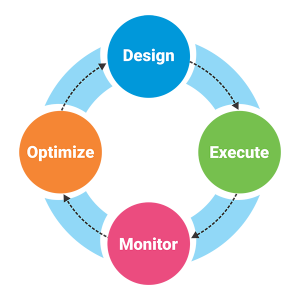
- Design: This foundational stage focuses on mapping out existing processes, identifying bottlenecks or pain points, and reimagining more efficient workflows. Teams collaborate to visualize how a process should function—considering inputs, outputs, roles, decision points, and potential risks.
- Execution: Once a process is designed, it’s time to bring it to life. This phase involves deploying the process in a live environment—using a mix of manual inputs, automated actions, and integrated systems. In a modern BPM setup, low-code or no-code platforms can help accelerate deployment without deep technical intervention.
- Management: Execution is just the beginning. The next step is actively managing and monitoring the process to ensure it’s performing as intended. This includes tracking KPIs, workload distribution, process timing, and exception handling—often through dashboards and alerts provided by your BPMS.
- Optimization: Business environments evolve, and so should your processes. This phase is all about iterating and improving based on performance insights, user feedback, and new business goals. Using analytics, teams can pinpoint inefficiencies, update workflows, and implement improvements continuously.
The BPM life cycle isn’t a one-time effort—it’s a continuous loop. Organizations that adopt this structured approach can stay agile, reduce operational waste, and build a culture of continuous improvement. As AI and automation reshape how we work, mastering the BPM life cycle will be critical for long-term success.
Also read: BPM Software – 11 things to consider for choosing the right one
Benefits of Business Process Management
Implementing Business Process Management (BPM) goes far beyond simply organizing tasks—it transforms the way organizations operate. By designing, executing, and optimizing workflows strategically, BPM delivers tangible, wide-reaching benefits across teams and departments.
Higher Productivity
When inefficiencies and redundant steps are removed from day-to-day operations, employees can focus on value-added work rather than chasing approvals or correcting errors. Clear, streamlined processes reduce confusion and help teams move faster with fewer interruptions.
Improved Satisfaction
This clarity and efficiency feed directly into enhanced satisfaction—both for employees and customers. Employees benefit from structured workflows that reduce stress and guesswork, while customers enjoy faster response times, consistent service, and a smoother overall experience.
Strategic Alignment
BPM helps ensure that operational activities are directly supporting larger business goals. With every process deliberately designed for outcomes, it becomes easier to track progress, measure success, and pivot strategies when needed.
Cost Savings
Automating repetitive, manual tasks reduces operational overhead while minimizing the risk of costly errors or delays. Over time, this creates leaner, more efficient processes without compromising control or quality.
Bonus Benefit: Agility and Compliance
Organizations that embrace BPM often report faster project delivery, improved regulatory compliance, and a more agile response to market changes. With well-managed processes, teams can adapt quickly—turning operational excellence into a long-term competitive edge.
Also Read: 10 Valuable Benefits of Business Process Management
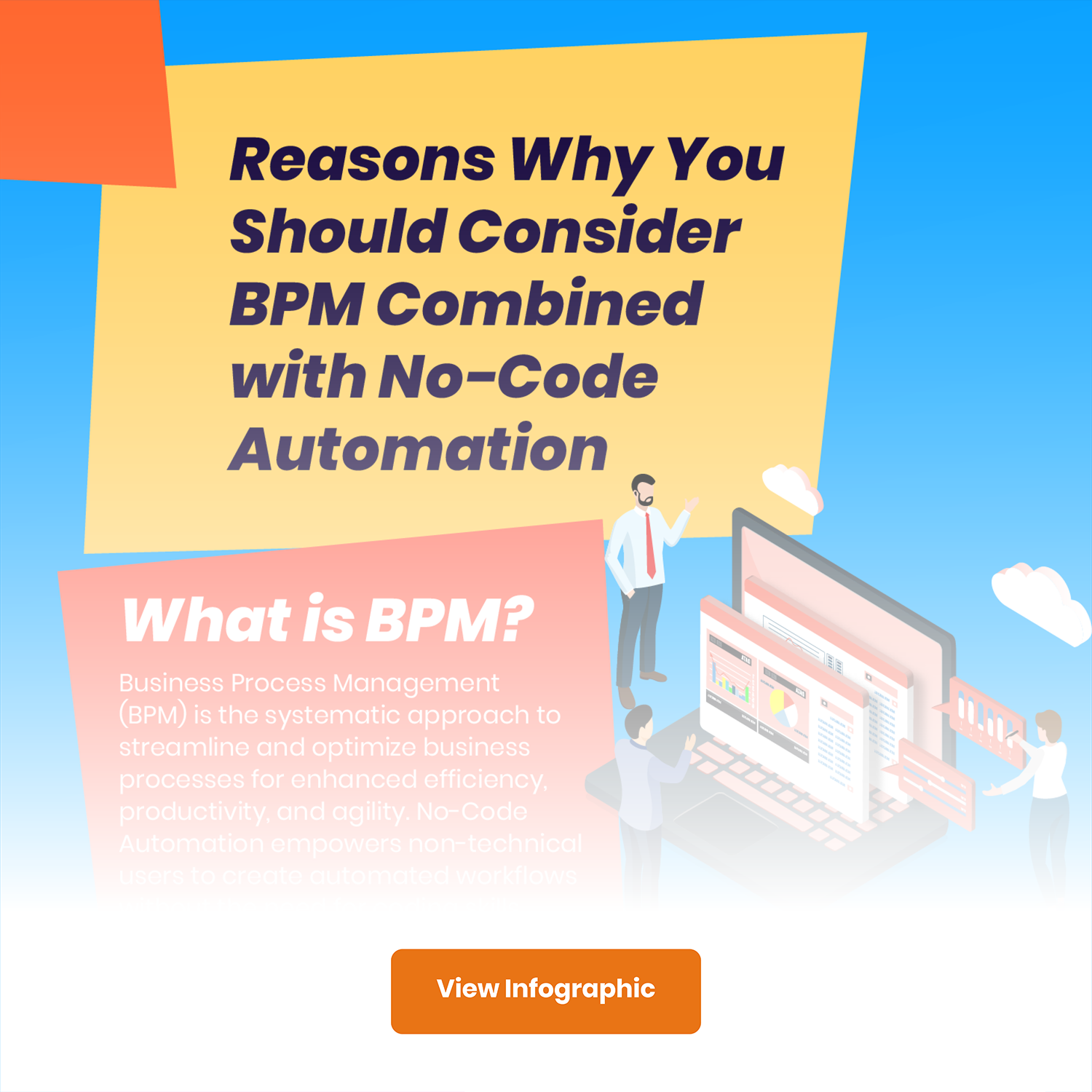
Reasons why you should consider BPM combined with automation
It’s time to understand the reasons why you should integrate BPM into your system. If you check any of the following boxes, you need it.
- No-code application development makes BPM easier. Businesses that use no-code development tend to build software programs much faster.
- It ensures all employees can access the right data by integrating it with the processes.
- All workflows will be streamlined.
- The workforce will be connected, and that’s a gigantic requirement for any business.
Also read: RPA and BPM: What’s the difference, and which one do you need?
Industries using Business Process Management
Let’s try to understand BPM better by picking up examples from various industries.
1. Education
Admission requirements, course certifications, and research grants. The list of processes is never ending in the education sector. Thank God for BPM!
2. Legal
The amount of paperwork one handles in the legal department is astounding. The manual process is quite tedious, from handling contracts to reviewing them and ensuring everything is on track. BPM definitely comes to the rescue.
3. Insurance
Claims data entry, membership life changes, membership application approval, and claim grievances are part and parcel of the insurance life. What better way to make all of these easier than with a business process management software program?

Examples of BPM in different functions
Now, we are going to talk about the use of BMP in different functions with the use of examples.
1. HR and administration
The onboarding process is one of the most chaotic tasks for the HR department. Did you know that BPM can streamline the process and that further automation can eliminate the need to fill out exhaustive paper forms? Of course! The same applies to employee timesheets as well.
2. Sales and marketing
Invoice approvals are painstaking. Sometimes, a typing error here or a math mistake there can stymie the whole process. BPM eliminates these obstacles through automation. There is literally no room for error!
3. Accounting and finance
Ah, how we pity the accounting team! They have so much to take care of and are often short-handed. The sheer number of emails they get per day is daunting. Now, imagine their workload! When you bring in BPM to such a troubled department, you ease the burden and smoothen the entire system. Travel requests, reimbursements, etc., can happen with one click!
4. Purchasing
The purchase approval system is so ancient in a few companies that it gives employees nightmares! And no, we are not even exaggerating! Rogue spending is a constant risk, along with human errors and a lack of transparency. You can say goodbye to all these issues with business process management.
5. IT
Business strategy, contract management, data security, operational efficiency, and project management – there’s barely anything that BPM won’t do for the IT industry.
Also Read: What is Collaboration Software? 6 Critical Factors For Selecting the Right Software
BPM Examples in Different Business Contexts

Explore real-world business process management examples showcasing transformative prowess across diverse industries, driving efficiency and innovation in unique contexts.
Retail Store Operations
A retail chain optimized store operations through BPM implementation. The BPM platform automated inventory management, sales tracking, and staff scheduling. This led to better inventory accuracy, improved sales insights, and optimized staffing levels.
Marketing Request Management
A leading life insurance and financial services company optimized marketing request handling by developing a custom BPM application. This platform enabled streamlined creation and routing of marketing requests, offering comprehensive visibility and standardizing the creative request process.
Supply Chain Logistics
A logistics company optimized supply chain operations using BPM technology. They automated order processing, inventory tracking, and shipment notifications. The BPM-enabled system improved order accuracy, reduced delivery times, and enhanced overall supply chain efficiency.
Claims Management
A global insurance company transformed its claims management system by utilizing BPM software. This initiative significantly reduced manual data entry, enhanced real-time reporting capabilities, and provided comprehensive process visibility by integrating various legacy systems into a unified platform.
Also Read: Best Collaboration Software to Look Out for
Employee Onboarding
A large organization streamlined employee onboarding through BPM, automating processes from candidate intake to new hire paperwork. Leveraging automation and robotic process automation (RPA), the BPM-enabled application facilitated smoother handoffs between teams, reducing manual efforts and ensuring a more efficient onboarding experience.
Healthcare Patient Journey
A healthcare provider optimized patient care journeys with BPM. They implemented a BPM solution to manage patient appointments, treatment plans, and follow-ups. This improved patient care coordination, reduced appointment scheduling errors, and enhanced overall healthcare service delivery.
Project Management
An organization enhanced project management efficiency by implementing a BPM-based application. This solution empowered project managers to choose predefined workflows, automate task assignments, track progress, and provide real-time notifications to manage critical project elements effectively.
Supplier Relationship Management
A manufacturing firm improved supplier relations by implementing BPM software. They automated supplier onboarding, performance monitoring, and payment processes. The BPM solution ensured better supplier visibility, reduced processing times, and facilitated proactive issue resolution.
Contract Management
A large real estate corporation revamped its contract management process using a BPM platform. By centralizing contracts and integrating with enterprise applications, the BPM solution facilitated collaborative contract management, delivering increased visibility and business intelligence across multiple subsidiaries.
Customer Service Management
A telecommunications company revamped its customer service operations using BPM. The BPM platform facilitated customer issue tracking, automated resolution processes, and offered a unified view of customer interactions. This led to faster query resolutions, improved customer satisfaction, and reduced service downtime.
Compliance and Risk Management
An organization focused on strengthening compliance and risk management procedures through BPM. This approach documented financial processes, conducted control tests, and tracked issues, offering real-time reporting, centralized audit information, and enhanced financial risk management.
Acquisition and Procurement
A government entity improved procurement operations and cost reduction through a BPM-based solution. This end-to-end procurement system enforced policy compliance, reduced acquisition cycle times, and generated substantial savings by streamlining pre-award, award, and post-award activities.
Lease Management
A prominent retailer streamlined lease tracking across numerous stores globally with BPM. By consolidating lease management processes, the BPM solution improved tracking accuracy, ensured compliance with critical deadlines, and offered better visibility into negotiation team performance.
Service Request Records
An equipment and services supplier elevated customer service by employing a BPM platform for service request management. This enabled efficient tracking of service requests, streamlined invoicing, and increased collaboration across departments, resulting in improved service cycles and enhanced customer experiences.
Inventory Management
A retail conglomerate optimized inventory control using BPM software. By implementing a BPM-based solution, they automated inventory tracking, managed stock levels, and streamlined procurement processes, ensuring better inventory management and cost-effective operations.
Also Read: Top Business Process Management Stats to help you add efficiency
BPM Technologies: Tools for Business Process Management
Business process management tools & technologies encompass various tools and approaches, including those that are code-free or “no-code” in nature. Here’s a breakdown of different types of BPM technologies:
- Traditional BPM Suites: These encompass software platforms that enable modeling, automation, monitoring, and optimization of complex business processes. They often require coding or scripting to create custom workflows.
- Low-Code BPM Platforms: The low-code platforms provide a visual interface and pre-built components, reducing the need for extensive coding. They cater to users with varying technical skills and expedite process development.
- No-Code BPM Platforms: No-code is designed for users with little to no coding knowledge, these platforms offer a graphical interface to design and automate processes. They empower non-developers to create functional workflows.
- Robotic Process Automation (RPA): While not strictly BPM, RPA involves using software bots to automate repetitive tasks. RPA tools can integrate with BPM systems to streamline processes.
- Process Mining Tools: These tools analyze existing processes based on actual data and provide insights into bottlenecks, inefficiencies, and opportunities for improvement.
- Digital Process Automation (DPA): Combines BPM, RPA, and other automation technologies to create end-to-end digital workflows. It often incorporates decision-making logic and integration with various systems.
- Case Management: Focuses on managing unstructured, knowledge-intensive processes where each case may follow a unique path. It’s particularly useful in industries like healthcare and legal.
- Cloud-Based BPM: Hosted in the cloud, these platforms offer scalability, accessibility, and collaboration features, allowing teams to work on processes remotely.
- Mobile BPM: Provides process access and management through mobile devices, catering to the increasingly mobile workforce.
- Social BPM: Incorporates social collaboration features to facilitate communication and collaboration among process participants.
- Adaptive Case Management (ACM): Similar to case management, ACM emphasizes the ability to adapt and respond to changing conditions, providing flexibility for complex, dynamic processes.
- Business Rules Management Systems (BRMS): Focuses on managing and automating business rules within processes, ensuring consistency and compliance.
Each type of BPM technology offers distinct advantages, and the choice depends on an organization’s specific needs, technical capabilities, and desired level of automation.
How to get started with BPM using No-Code Technology
We are positive that we have convinced you about BPM. Let’s see how you can get started with it now.
1. Use of no-code and low-code platforms for BPM
Our era calls for the convenience of no-code and low-code app development. This is why we must look at how you can use these platforms for BPM. They work to remove all complications in the process of development. Any business can create a BPM solution with minimal resources and effort. You don’t even need to spend a lot of money because you won’t hire professional coders for it. You can also customize the tool to your needs and remove all unnecessary functions.
2. No-code and low-code platforms for BPM versus the old tools
Traditional BPM tools are still prevalent, but we think it is time to shun them. Why? They are complicated. They are also very expensive and time-consuming. With new no-code and low-code platforms, you can enjoy the following:
- Faster delivery
- Customer-centric processes
- Continuous improvement based on analysis and feedback
- Low costs
3. Benefits of no-code over low-code platforms
While low-code platforms are an upgrade and shower multiple benefits on the user, why stop? Today, no-code platforms are ruling the roost with their 0% complexity formula. They require absolutely no technical knowledge, and anyone can build a BPM application from scratch. Low-code platforms still require basic tech knowledge, whereas no-code application development is so simple anyone can use them.
Business process management and workflow automation through no-code platforms are the need of the hour and the future of application development. The faster businesses embrace it; the easier it will be for them to navigate daily business needs and processes.
Also read: Everything you should know about no-code development
What are the Challenges of Business Process Management?
Business Process Management (BPM) comes with its share of challenges that organizations must navigate to successfully implement and maintain effective processes. Some of the key challenges include:
- Resistance to Change: Employees may resist process changes, impeding adoption.
- Process Complexity: Managing intricate processes involving multiple factors.
- Ownership Ambiguity: Lack of clear accountability for process performance.
- Technology Integration: Difficulty in integrating BPM tools with existing systems.
- Continuous Improvement: Resource-intensive nature of ongoing process refinement.
- Change Management: Navigating role changes during BPM implementation.
- Flexibility Balance: Adapting processes to change while maintaining standardization.
- Data Quality: Dependence on accurate and accessible data for effective BPM.
- Employee Engagement: Ensuring employees understand and embrace new processes.
- Effective Metrics: Identifying relevant metrics to measure process success.
- Technology Focus: Need to balance technology with process and people considerations.
- Cultural Shift: Overcoming resistance to adopting a process-oriented culture.
- Scope Control: Preventing expansion of BPM initiatives beyond manageable levels.
Also Read: Top Business Process Management Tools For Your Business
Addressing Challenges in Business Process Management (BPM) Implementation
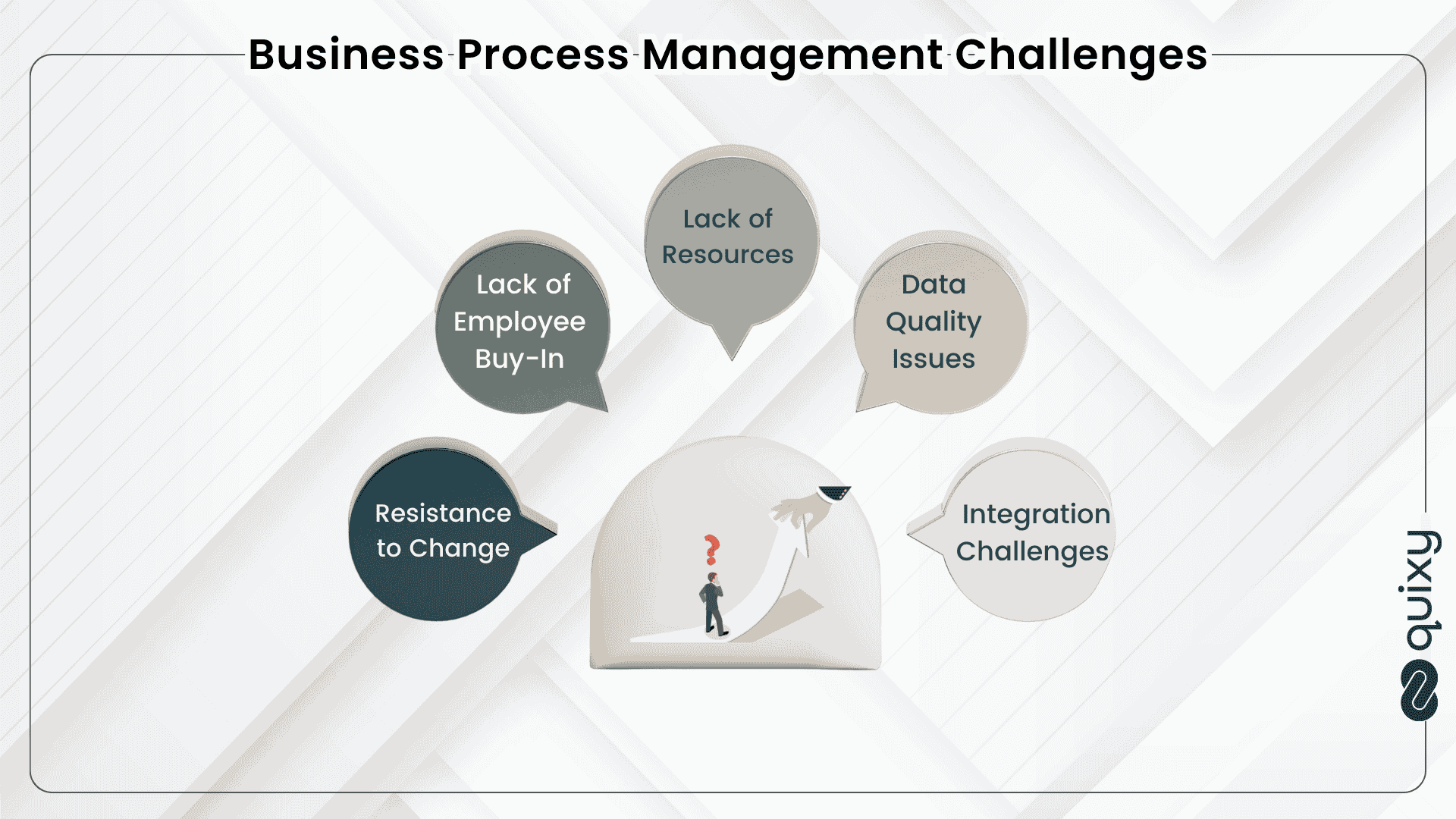
While implementing BPM offers numerous benefits, organizations often encounter challenges along the way. Here are some common hurdles and potential solutions:
Challenge 1: Resistance to Change
- Solution: Foster a culture of open communication and transparency throughout the process. Explain the purpose of BPM and its potential benefits for employees. Encourage participation and feedback during process analysis and design.
Challenge 2: Lack of Employee Buy-In
- Solution: Provide comprehensive training and support to equip employees with the necessary skills and knowledge to navigate the new processes. Address concerns and actively listen to employee feedback. Highlight the positive impact of BPM on individual work experiences and career development.
Challenge 3: Data Quality Issues
- Solution: Conduct thorough data audits to identify and address any inconsistencies or inaccuracies within existing data sets. Invest in data cleansing and standardization efforts before integrating systems or automating processes. Implement data governance policies to maintain data quality throughout the process lifecycle.
Challenge 4: Integration Challenges
- Solution: Conduct a thorough analysis of existing IT infrastructure and identify potential compatibility issues. Choose a BPM system that offers seamless integration capabilities with existing software and applications. Partner with experienced professionals to ensure smooth system integration and data exchange.
Challenge 5: Lack of Resources
- Solution: Consider starting small and focusing on automating and optimizing specific processes initially rather than attempting a complete organizational overhaul. Explore cost-effective BPM solutions, including no-code/low-code platforms, that require minimal initial investment and offer scalability as your needs evolve.
By proactively addressing these challenges and implementing appropriate solutions, organizations can navigate the BPM implementation process more effectively and achieve their desired outcomes.
Also Read: Quixy as Your Business Process Management Software
Quixy for Your Business Process Management
Quixy stands out as a advance low-code no-code Business Process Management (BPM) platform, purpose-built to help organizations automate and optimize their operations—up to 10x faster than traditional methods. Its intuitive interface, coupled with enterprise-grade functionality, makes process transformation accessible to both IT and business users.
- Accelerated Automation Without Code
With Quixy’s drag-and-drop workflow builder, teams can design and deploy process automation solutions without writing a single line of code. This empowers departments like HR, finance, legal, procurement, and customer support to build custom workflows tailored to their exact needs—quickly and independently. - Built-in Analytics for Smarter Decisions
Quixy doesn’t just automate processes—it helps you monitor and improve them with real-time dashboards, reports, and performance insights. This data-driven approach ensures your processes stay aligned with KPIs, SLAs, and evolving business goals. - Seamless Integration Across Your Tech Stack
Whether you need to connect with ERPs, CRMs, legacy systems, or modern SaaS tools, Quixy’s integration capabilities ensure that workflows stay unified and data flows effortlessly across platforms. This makes end-to-end automation truly scalable. - Empower Every Team to Drive Change
By removing technical barriers, Quixy gives process ownership back to business users. Teams across the organization can digitize approvals, streamline documentation, and eliminate manual bottlenecks—all while IT maintains control and governance.
If you’re looking to unlock the full potential of BPM with speed, flexibility, and zero coding overhead, Quixy offers everything you need to get there—smarter, faster, and future-ready.
Conclusion
Business Process Management (BPM) is far more than a trending term—it’s a strategic imperative for organizations seeking efficiency, agility, and long-term success. In a world defined by speed, data, and constant change, BPM provides the structure needed to align operations with business goals.
When combined with the power of advance no-code low-code platforms, BPM becomes even more accessible and transformative. It empowers teams to redesign workflows, eliminate inefficiencies, and innovate faster—without depending solely on IT.
For businesses ready to streamline operations and build a future-ready foundation, embracing BPM with no-code technology isn’t just a smart move—it’s a competitive advantage.
Get started with Quixy, and experience the ease of automated processes and personalized app building.
Frequently Asked Questions(FAQs)
Q. Is BPM expensive?
The cost associated with Business Process Management (BPM) can vary widely depending on factors such as the complexity of the processes, the scale of implementation, the chosen technology, and the level of customization required. While traditional BPM solutions can sometimes involve significant upfront expenses, no-code BPM platforms have introduced a more cost-effective and accessible option.
Q. What is a Business Process Management (BPM) System?
A BPM system is a software solution designed to model, automate, optimize, and manage an organization’s business processes. It helps streamline workflows, improve efficiency, and enhance collaboration among teams.
Q. How to choose right BPM system as per my business needs?
To select the ideal BPM system, consider factors like industry alignment, scalability, integration options, customization capabilities, and user-friendliness. Assess how well the system can adapt to your unique processes, accommodate growth, and integrate with existing tools. Prioritize a solution that empowers efficient process design, automation, and monitoring while aligning with your business goals.
Q. What are benefits of adopting a BPM system for any organization?
Adopting a BPM system brings manifold benefits to your organization. It enhances operational efficiency by streamlining processes, reduces errors through standardized workflows, ensures compliance with regulations, fosters team collaboration, and provides real-time insights for informed decision-making. Also, it boosts agility by facilitating quick process modifications and adaptations, leading to improved customer satisfaction and a competitive edge in a dynamic business landscape.
Q. Can a BPM system be integrated with existing systems?
Yes, most BPM systems are designed with integration capabilities in mind. These systems can seamlessly integrate with your existing software applications, databases, and systems. This integration facilitates the exchange of data and information, allowing for smoother process execution and improved communication between different parts of your organization.
Q. Can a BPM system handle complex processes?
Yes, BPM systems are indeed equipped to manage intricate and evolving processes. With features like adaptable workflow setups, dynamic case management, and the ability to model complex processes with multiple decision points, BPM systems address sophisticated requirements.
Subscribe
Login
Please login to comment
0 Comments
Oldest
